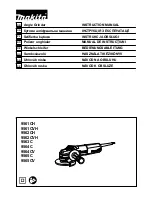
13
ENGLISH
SÉCURITÉ D'UTILISATION DU MOTEUR
Failure to follow these safety precautions may result in
severe injury to yourself and others.
❍
Keep all engine fuel in a safe place, away from high heat,
sparks or flames, as fuel is very flammable. Do not smoke
near the engine or fuel; and remember that engine
exhaust gives off a great deal of deadly carbon monoxide.
Therefore do not run the engine in a closed room or
garage.
❍
Get help from an experienced pilot when learning to
operate engines.
❍
Use safety glasses when starting or running engines.
❍
Do not run the engine in an area of loose gravel or sand;
the propeller may throw such material in your face or
eyes.
❍
Keep your face and body as well as all spectators away
from the plane of rotation of the propeller as you start
and run the engine.
❍
Keep these items away from the prop: loose clothing,
shirt sleeves, ties, scarfs, long hair or loose objects such as
pencils or screwdrivers that may fall out of shirt or jacket
pockets into the prop.
❍
Use a “chicken stick” or electric starter to start the engine.
❍
Do not use your fingers to flip the propeller.Make certain
the glow plug clip or connector is secure so that it will not
pop off or otherwise get into the running propeller.
❍
Make all engine adjustments from behind the rotating
propeller.
❍
The engine gets hot! Do not touch it during or right after
operation. Make sure fuel lines are in good condition so
fuel will not leak onto a hot engine, causing a fire.
❍
To stop a glow engine, cut off the fuel supply by closing
off the fuel line or following the engine manufacturer's
recommendations. Do not use hands, fingers or any
other body part to try to stop the engine. Do not throw
anything into the propeller of a running engine.
RANGE CHECK
Ground check the operational range of your radio before the
first flight of the day. With the transmitter antenna collapsed
and the receiver and transmitter on, you should be able
to walk at least 100 feet away from the model and stil have
control. Have an assistant stand by your model and, while you
work the controls, tell you what the control surfaces are doing.
Repeat this test with the engine running at various speeds with
an assistant holding the model, using hand signals to show
you what is happening. If the control surfaces do not respond
correctly, do not fly! Find and correct the problem first. Look
for loose servo connections or broken wires, corroded wires
on old servo connectors, poor solder joints in your battery
pack or a defective cell, or a damaged receiver crystal from a
previous crash.
Summary of Contents for FLW4090
Page 15: ...15 ENGLISH NOTES ...


































